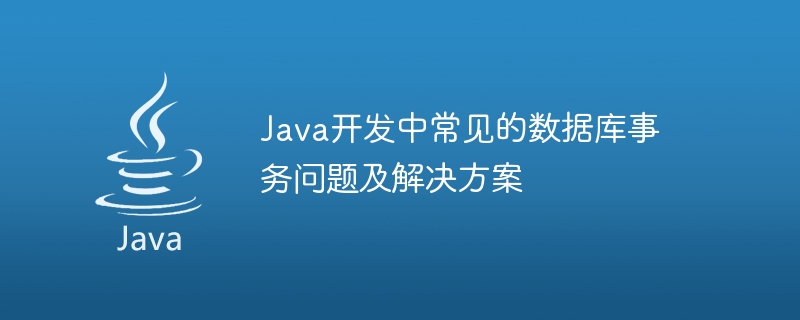Home >Java >javaTutorial >Common database transaction problems and solutions in Java development
Common database transaction problems and solutions in Java development
- WBOYWBOYWBOYWBOYWBOYWBOYWBOYWBOYWBOYWBOYWBOYWBOYWBOriginal
- 2023-10-08 20:46:42871browse

Common database transaction problems and solutions in Java development
Introduction:
In Java development, database transactions are a very common and important concept. Transactions can ensure the consistency and isolation of database operations and ensure data integrity. However, in the actual development process, we will encounter many problems related to database transactions. This article will introduce some common database transaction problems and provide corresponding solutions and sample code.
1. Concurrency issues caused by transaction isolation level
Transaction isolation level is an important mechanism for database to control concurrent access. Different isolation levels correspond to different concurrency issues. The most common concurrency problems include dirty reads, non-repeatable reads, and phantom reads.
- Dirty reading
Dirty reading refers to problems caused by one transaction when reading uncommitted data from other transactions. A common way to solve dirty reads is to set the isolation level to read committed (READ_COMMITTED), which ensures that a transaction can only read data from other committed transactions.
Sample code:
Connection connection = dataSource.getConnection(); connection.setTransactionIsolation(Connection.TRANSACTION_READ_COMMITTED);
- Non-repeatable reading
Non-repeatable reading refers to reading the same data multiple times. Between two reads, there are Another transaction modified the data. A common way to solve non-repeatable reads is to set the isolation level to repeatable reads (REPEATABLE_READ). This ensures that while one transaction is reading data, other transactions will not modify the data.
Sample code:
Connection connection = dataSource.getConnection(); connection.setTransactionIsolation(Connection.TRANSACTION_REPEATABLE_READ);
- Phantom reading
Phantom reading refers to when the same data set is queried twice within a transaction, the second query occurs Data that does not exist in the first query. A common way to solve phantom reads is to set the isolation level to SERIALIZABLE, which ensures that while one transaction is reading data, other transactions will not perform any operations on the data.
Sample code:
Connection connection = dataSource.getConnection(); connection.setTransactionIsolation(Connection.TRANSACTION_SERIALIZABLE);
2. Transaction management issues
- Transaction rollback
In development, transaction rollback is very common operate. When an exception occurs or certain conditions are not met, the transaction needs to be rolled back. In order to avoid a large number of manual rollback operations in the code, we can use the @Transactional annotation provided by the Spring framework to automatically rollback the transaction through the exception mechanism.
Sample code:
@Transactional
public void insertData(Data data) {
//插入数据操作
dataDao.insert(data);
if (conditionNotMet) {
throw new RuntimeException("条件不满足,回滚事务");
}
}- Distributed transaction management
In a distributed system, transactions between multiple databases need to maintain consistency. Requires the use of a distributed transaction manager. Common distributed transaction managers include JTA (Java Transaction API) and Atomikos. These transaction managers ensure that transactions across multiple databases remain consistent in a distributed environment.
Sample code:
@Transactional
public void updateData() {
//更新数据库1数据
dataDao.update(db1Data);
//更新数据库2数据
dataDao.update(db2Data);
}3. Deadlock problem and solution
- Deadlock problem
Deadlock refers to two or more Multiple transactions are waiting for each other's resources, resulting in a state where the system cannot continue. In order to solve the deadlock problem, we can use the lock timeout mechanism provided by the database. When a transaction waits for a lock for more than a certain period of time, a timeout exception is thrown and the transaction is terminated.
Sample code:
Connection connection = dataSource.getConnection();
Statement statement = connection.createStatement();
boolean success = statement.tryLock(timeOut);
if (!success) {
throw new RuntimeException("获取锁超时,终止事务");
}- Avoid deadlock
In order to avoid deadlock problems, we can reasonably design the transaction process and minimize the time the transaction holds the lock. . Additionally, you can use the database's row-level locking mechanism instead of table-level locks. The granularity of row-level locks is smaller, which can reduce the chance of deadlock.
Sample code:
Connection connection = dataSource.getConnection();
connection.setAutoCommit(false);
PreparedStatement statement = connection.prepareStatement("UPDATE table SET column = ? WHERE id = ?");
statement.setString(1, value);
statement.setLong(2, id);
statement.executeUpdate();
connection.commit();Conclusion:
Database transactions are a very important concept in Java development, which can ensure the consistency and isolation of data. However, during the development process, you will encounter some problems related to database transactions, such as concurrency problems, transaction management problems, and deadlock problems. By properly setting isolation levels, using transaction management annotations, using distributed transaction managers, and properly designing transaction processes, we can solve these problems and ensure the stability and reliability of the system.
References:
1. "Detailed Explanation of High Concurrency Programming in Java: Multi-Threading and Architecture Design"
2. "Spring in Practice (4th Edition)"
The above is the detailed content of Common database transaction problems and solutions in Java development. For more information, please follow other related articles on the PHP Chinese website!
Related articles
See more- php mysql_connect() unsupported solution_PHP tutorial
- After the phpstudy2018 upgrade, the site and phpmyadmin open the 404 solution
- The latest 'The website you want to visit contains malware', Baidu apps.bdimg.com is blocked by Google Chrome solution!
- Detailed introduction to the solution for mysql forgotten password and three ways to change the password
- How to solve the problem of high concurrency (product flash sale) in PHP? Two solutions shared

